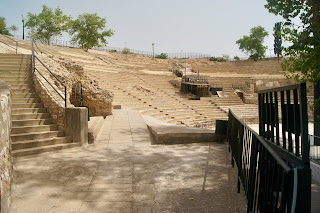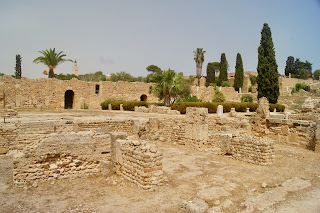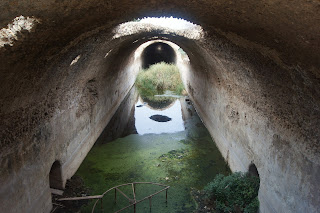Hi everyone,
Nearly two months have passed since our arrival in Monastir. Over the last month we've explored El Jem, Mahdia, Sousse and Carthage.
 |
| El Jem Roman Amphitheatre |
El Jem
We toured El Jem and Mahdia in company with Jean-Luc and Nadia of sv Silence. Together we borrowed a car from another cruiser which made the visit to El Jem much easier.
El Jem is famous for its huge Roman amphitheatre. It is the second largest in the world and very well preserved. And one can wander through most of it. The 'tunnel' excavated under the stage is well preserved, including the lion's pens, the Christian's pen, the gladiator's pens, the mortuary and the water reservoir. Two elevators lifted the combatants up to the stage.
 |
| Accommodation for 30,000 spectators, 7 lions and 20 Christians |
 |
| Gladiator's Passage and Entries |
 |
| Spectator Passageways |
 |
| 2000 years of graffiti |
 |
| The 'tunnel' under the stage |
 |
| Lion pen with stands for a cage and a water trough |
 |
| The water store was fed from the entire amphitheatre |
 |
| At the Amphitheatre (Nadia Rabhi photo) |
Mahdia
From El Jem we drove on to the coastal town of Mahdia. The town has a large Ribat and ruins of a Punic harbour.
 |
| Mahdia Ribat |
 |
| Remains of Punic arch with modern replica |
 |
| Punic harbour with original sea wall |
 |
| Lunch overlooking the beach at Mahdia |
 |
| Innovative plastic recycling scheme? |
 |
| Tunisians love their brightly painted metal front doors |
 |
| Extensive shade over a Mahdia Cafe |
 |
| Mahdia Medina |
 |
| Colourful Clothing Displays |
 |
| Coastal Salt Flats with Flamingoes |
 |
| Back in Monastir - the car didn't need pushing thankfully! |
Sousse
We took the 'metro' train from Monastir to Sousse to visit the Archeological Museum and the Museum Dar Essid. The former was so good we ran out of time so will have to return for the latter! The train fare is only 1 TND (0.50 AUD) per person each way.
The museum accommodates an array of Roman and other items. Most impressive are the mosaics, many of which are 2m by 2m in size.
 |
| Approaching the Sousse Archeological Museum entrance |
 |
| Inside the museum |
 |
| Roman mosaic |
 |
| Roman mosaic of Neptune |
 |
| Mosaic depicting four types of fishing |
 |
| Roman mosaic |
 |
| Large Roman mosaic of the Gorgon Medusa |
 |
| 4th Century Christian Baptism Font |
Carthage
Most recently we did a day trip to Tunis to explore Carthage. We took the direct train from Monastir to Tunis departing at 0615. It's busy and a bit of a bone-shaker and with luck it gets you there at 0900.
 |
| Mahdia - Tunis Train |
It took us about half an hour to find a taxi. Our driver spoke English and gave us a full tour of Carthage for 50 TND on the meter plus a tip. We visited Punic sites, Roman sites and the tourist town of Sidi Bou Said before finishing in central Tunis.
The amphitheatre in Carthage is much smaller and less well preserved than that at El Jem. Apparently here the Romans allowed the Christians to pray at a small shrine before leading them to the elevator.
 |
| Roman Amphitheatre |
 |
| "Tunnel" under Roman Amphitheatre stage |
 |
| Shrine where Christians were allowed to pray in the Amphitheatre |
The main museum building in Carthage was closed for renovations but the site was open. There are Punic building remains, apparently not destroyed by the Romans since they're some distance from the main original city of Carthage.


























































Excellent blog Mike. It looks like you guys are still abĺe to get out and about ok despite Covid. All the best Paul and Karen
ReplyDeleteThanks. No land travel restrictions. Come join us!
Delete